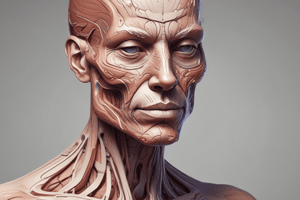Podcast
Questions and Answers
What is the primary function of sebaceous glands?
What is the primary function of sebaceous glands?
- To regulate body temperature
- To filter toxins from the blood
- To produce sebum (correct)
- To produce sweat
What is the rate of hair growth per day?
What is the rate of hair growth per day?
- 0.1-0.2 mm/day
- 0.3-0.4 mm/day (correct)
- 1-2 mm/day
- 0.5-0.6 mm/day
What is the term for the process of removing dead tissue from a wound?
What is the term for the process of removing dead tissue from a wound?
- Inflammation
- Proliferation
- Remodeling
- Debridement (correct)
What is the primary cause of acne?
What is the primary cause of acne?
What is the innermost layer of the skin?
What is the innermost layer of the skin?
What is the term for the nail plate, nail bed, and nail matrix?
What is the term for the nail plate, nail bed, and nail matrix?
What is the primary function of eccrine glands?
What is the primary function of eccrine glands?
What is the final stage of wound healing?
What is the final stage of wound healing?
Flashcards are hidden until you start studying
Study Notes
Skin Anatomy
- The skin is composed of three main layers:
- Epidermis: outermost layer, thin, and avascular
- Dermis: middle layer, thicker, and vascular
- Hypodermis: innermost layer, composed of adipose tissue
- Skin appendages:
- Hair follicles
- Sebaceous glands
- Sweat glands
- Nails
Hair And Nail Structure
- Hair:
- Composed of keratin, a protein
- Has a root, shaft, and follicle
- Growth rate: 0.3-0.4 mm/day
- Nail:
- Composed of keratin and dead cells
- Has a nail plate, nail bed, and nail matrix
- Growth rate: 0.1-0.2 mm/day
Sweat And Sebaceous Glands
- Sweat glands:
- Produce sweat, a clear, watery fluid
- Two types: eccrine and apocrine
- Eccrine glands: found all over the body, produce sweat in response to heat and stress
- Apocrine glands: found in armpits and groin, produce sweat in response to emotional stress
- Sebaceous glands:
- Produce sebum, an oily substance
- Found in the dermis, associated with hair follicles
- Help to moisturize the skin and hair
Skin Disorders
- Common skin disorders:
- Acne: caused by clogged pores and bacterial infection
- Eczema: caused by inflammation and dry skin
- Psoriasis: caused by rapid skin cell growth
- Skin cancer: caused by UV radiation and genetic mutations
Wound Healing
- Stages of wound healing:
- Inflammation: blood clot forms, and immune cells respond to injury
- Debridement: dead tissue is removed
- Proliferation: new tissue is generated
- Remodeling: new tissue is strengthened
- Factors that affect wound healing:
- Age
- Nutrition
- Infection
- Diabetes
FUNCTIONS OF THE SKIN
- Protection:
- Barrier against external factors (e.g. temperature, UV radiation)
- Prevents water loss
- Regulation:
- Thermoregulation: helps to regulate body temperature
- Blood pressure regulation: helps to regulate blood pressure
- Sensation:
- Detects sensations such as touch, pressure, and temperature
- Excretion:
- Removes waste products through sweat
- Production:
- Produces vitamin D upon UV radiation exposure
Skin Anatomy
- The skin is composed of three main layers: epidermis, dermis, and hypodermis
- Epidermis is the outermost layer, thin, and avascular
- Dermis is the middle layer, thicker, and vascular
- Hypodermis is the innermost layer, composed of adipose tissue
Skin Appendages
- Skin appendages include hair follicles, sebaceous glands, sweat glands, and nails
Hair Structure
- Hair is composed of keratin, a protein
- Hair has a root, shaft, and follicle
- Hair growth rate is 0.3-0.4 mm/day
Nail Structure
- Nails are composed of keratin and dead cells
- Nail has a nail plate, nail bed, and nail matrix
- Nail growth rate is 0.1-0.2 mm/day
Sweat Glands
- Sweat glands produce sweat, a clear, watery fluid
- There are two types of sweat glands: eccrine and apocrine
- Eccrine glands are found all over the body, produce sweat in response to heat and stress
- Apocrine glands are found in armpits and groin, produce sweat in response to emotional stress
Sebaceous Glands
- Sebaceous glands produce sebum, an oily substance
- Found in the dermis, associated with hair follicles
- Help to moisturize the skin and hair
Skin Disorders
- Acne is caused by clogged pores and bacterial infection
- Eczema is caused by inflammation and dry skin
- Psoriasis is caused by rapid skin cell growth
- Skin cancer is caused by UV radiation and genetic mutations
Wound Healing
- Stages of wound healing: inflammation, debridement, proliferation, and remodeling
- Factors that affect wound healing: age, nutrition, infection, and diabetes
Functions of the Skin
- Protection: barrier against external factors, prevents water loss
- Regulation: thermoregulation, blood pressure regulation
- Sensation: detects sensations such as touch, pressure, and temperature
- Excretion: removes waste products through sweat
- Production: produces vitamin D upon UV radiation exposure
Studying That Suits You
Use AI to generate personalized quizzes and flashcards to suit your learning preferences.




